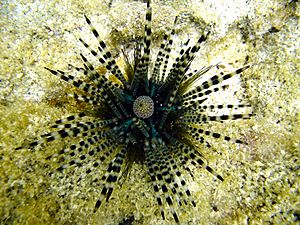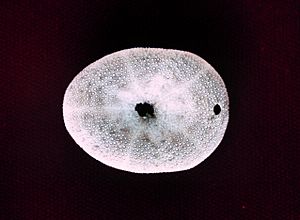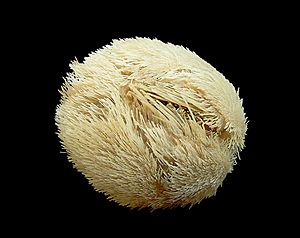List of echinoderms of the Houtman Abrolhos facts for kids
The Houtman Abrolhos is a group of islands off the coast of Western Australia. Its ocean waters are home to an amazing 172 different types of echinoderms. These creatures are often called "spiny-skinned animals."
This huge variety of echinoderms is due to a few special reasons. First, the Houtman Abrolhos is in a unique spot. It's a "biotone," which means it's a place where cool, temperate waters meet warm, tropical waters. This allows both types of species to live there. Second, the islands have many different kinds of underwater homes, like coral reefs and sandy areas. Finally, the Leeuwin Current plays a big role. This warm ocean current flows south, bringing tropical animals with it. It also keeps the reefs warm enough for these tropical species to survive and thrive.
This article will tell you more about the different kinds of echinoderms found in the Houtman Abrolhos.
Contents
What are Echinoderms?
Echinoderms are a group of marine animals. Their name means "spiny skin." They usually have a special kind of body symmetry. This means their body parts are arranged around a central point. Think of a starfish with its arms radiating out. They also have a unique water vascular system. This system helps them move, grab food, and breathe.
Crinoidea: Sea Lilies and Feather Stars

Crinoidea are some of the oldest living echinoderms. They are often called sea lilies or feather stars. Sea lilies attach themselves to the seafloor with a stalk. Feather stars can move around freely. They both have many feathery arms. These arms help them filter tiny bits of food from the water. They look a bit like plants, but they are definitely animals!
Asteroidea: Sea Stars (Starfish)
Sea stars, also known as starfish, are probably the most famous echinoderms. They usually have five arms, but some can have many more. They move using tiny tube feet on their underside. These tube feet also help them grip surfaces and open the shells of their prey, like clams. Sea stars are predators and play an important role in their ecosystem. For example, the Patiriella brevispina is a purple seastar found here. Another interesting one is the Coscinasterias calamaria, known as the eleven-armed seastar.
Ophiuroidea: Brittle Stars and Basket Stars
Brittle stars look a lot like sea stars, but their arms are much thinner and more flexible. They use these arms to move quickly across the seafloor. If a brittle star is attacked, it can even drop an arm to escape! The arm can then grow back later. Basket stars are a type of brittle star with highly branched arms. They spread their arms out to catch food floating in the water.
Echinoidea: Sea Urchins, Sand Dollars, and Sea Biscuits
Echinoidea includes sea urchins, sand dollars, and sea biscuits. Sea urchins are round and covered in sharp spines. They use these spines for protection and to help them move. They often graze on algae. The Diadema setosum is a long-spined sea urchin found in the Abrolhos. The Echinothrix calamaris is known as the double spined urchin.
Sand dollars and sea biscuits are flatter and often covered in short, velvety spines. They usually live in sandy areas. The Clypeaster reticulatus is a type of cake urchin. The Echinocardium cordatum is another species found here.
Holothuroidea: Sea Cucumbers
Sea cucumbers have soft, elongated bodies that look a bit like a cucumber. They don't have arms or spines like other echinoderms. They move slowly along the seafloor, often eating tiny bits of food from the sand or mud. Some sea cucumbers have amazing defense mechanisms. For example, if threatened, some can shoot out sticky threads or even internal organs! They can then regrow these parts later. The Holothuria leucospilota is one type of sea cucumber found here. Another is the Leptosynapta dolabrifera, sometimes called a snot sea cucumber due to its texture.
Images for kids
See also
 In Spanish: Anexo:Equinodermos de Houtman Abrolhos para niños
In Spanish: Anexo:Equinodermos de Houtman Abrolhos para niños





